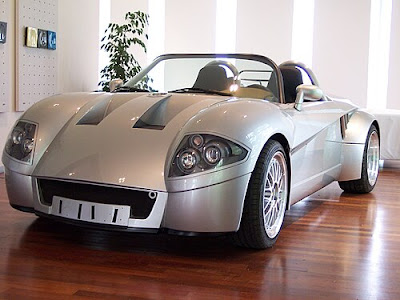Mechanical Mischief - In a world where cars are getting more connected, more digital, and more automated, there’s still something irresistibly cool about a machine that’s loud, light, and looks like it was built for fun rather than fuel economy. That’s what makes the YES! Roadster so fascinating—a car that feels like a rebellious shout in an era of polite electric whirs.
 |
| The YES! Roadster 2nd Generation was introduced to the public in 2006, and while it gained more refinement, it remained proudly unconventional and stayed true to the untamed spirit that made the original so unique. (Picture from: Carscoops) |
And before we go any further, let’s take a moment to talk about that name—YES! It’s unusual, almost comically simple, and topped off with an exclamation mark like it’s already cheering itself on. It doesn’t exactly sound like a car brand—more like a catchy slogan or maybe an old-school energy drink. But behind that quirky name is one of the most eccentric and overlooked sports cars ever built in Germany. As it turns out, YES actually stands for Young Engineers Sportscar—a fitting title for a car born from youthful ambition and fearless engineering.
 |
| The YES! Roadster 2nd Generation, with its aggressive stance, bulging fenders, and low-slung silhouette, looked more like something a gamer would mod into Grand Theft Auto than a car you'd expect to see at a local track day. (Picture from: Carscoops) |
The YES! Roadster was the brainchild of two young engineers, Herbert Funke and Philipp Will, who went on to establish their own company, Funke & Will AG. Unlike the major players of the automotive world, they weren’t trying to rival Porsche or BMW—their ambition was much simpler: to build a raw, uncompromising sports car that focused purely on driving fun. Their first creation launched in 2001 under the name YES! Clubsport—a lightweight, minimalist machine that captured their vision. This eventually evolved into the first-generation Roadster, introduced in 2003.
 |
| The YES! Roadster 2nd Generation, powered by a 3.2-liter V6 sourced from Audi and offered in both naturally aspirated and turbocharged forms. (Picture from: Carscoops) |
That same year, the YES! Cup/R was introduced as a track-only version of the Roadster. Designed for the circuit, this model took the lightweight philosophy even further—shedding everything non-essential, including the doors. The result was an ultra-focused performance machine, now equipped with a more powerful engine delivering 340 horsepower. By 2006, the concept matured into the second-generation Roadster. While it gained a touch more refinement, it remained proudly unconventional and never strayed from the untamed spirit that made the original so unique.
 |
| The YES! Clubsport, launched in 2001 as the first production car from Funke & Will AG, featured a 1.8-liter turbocharged inline-four from Volkswagen producing 281.6 horsepower, built on a lightweight aluminum space frame. (Picture from: Wikipedia) |
Visually, the Roadster was an attention-grabber. With its aggressive stance, bulging fenders, and low-slung silhouette, it looked more like something a gamer would mod into Grand Theft Auto than something you’d expect to see at a local track day. But this wasn’t just about style—it had the guts to match.
 |
| The first-generation YES! Roadster was the next model from Funke & Will AG, introduced to the public in 2003. (Picture from: UltimateCarPage) |
Under the hood was a 3.2-liter V6 sourced from Audi, offered in both naturally aspirated and turbocharged forms. The turbo version was the real deal, pushing out 350 horsepower and 450 Nm of torque. That kind of output in a car weighing just 920 kilograms (2,028 pounds) meant blistering acceleration: 0 to 100 km/h in just 3.9 seconds. Even two decades later, that’s properly quick.
 |
| The YES! Roadster 1st Generation includes comfort features such as central door locking—absent in the Clubsport model—which makes it heavier by comparison. (Picture from: UltimateCarPage) |
The YES! Roadster wasn’t just fast in a straight line, either. With its mid-engine layout, lightweight body, and manual transmission option, it was built to make drivers feel everything. No frills, no excessive tech layers—just an old-school, seat-of-your-pants experience. And coming from a company most people had never heard of, that made it all the more surprising.
 |
| The YES! Cup/R, introduced in 2003 as a track-only version of the Roadster, was designed for the circuit and pushed the lightweight philosophy even further by stripping away all non-essential components, including the doors. (Picture from: Wikipedia) |
Even with all its clever engineering and impressive performance, Funke & Will AG. couldn’t escape the harsh realities of the automotive world. The company went bankrupt in 2009, and it’s believed that fewer than 200 YES! Roadsters—across all variants—were ever built. That level of rarity, paired with the car’s outrageous design and thrilling capabilities, makes it one of the most unique and intriguing sports cars to emerge from the early 2000s. | jCAdJpPwc1g | hzGp2PBPtHs |
 So while the name might sound odd at first—almost like a joke—the YES! Roadster is anything but. It’s a wild, confident, and genuinely thrilling machine that dared to be different in a world of predictable designs. And maybe, just maybe, that weird little name was the perfect fit all along. *** [EKA | FROM VARIOUS SOURCES | CARSCOOPS | DAVEYJAPAN | WIKIPEDIA | ULTIMATECARPAGE | FORUM.FORZA.NET ]
So while the name might sound odd at first—almost like a joke—the YES! Roadster is anything but. It’s a wild, confident, and genuinely thrilling machine that dared to be different in a world of predictable designs. And maybe, just maybe, that weird little name was the perfect fit all along. *** [EKA | FROM VARIOUS SOURCES | CARSCOOPS | DAVEYJAPAN | WIKIPEDIA | ULTIMATECARPAGE | FORUM.FORZA.NET ]Note: This blog can be accessed via your smart phone.

